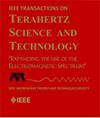圆极化太赫兹通信中基于ltcc的致密自序贯旋转馈电天线阵列
IF 3.9
2区 工程技术
Q2 ENGINEERING, ELECTRICAL & ELECTRONIC
IEEE Transactions on Terahertz Science and Technology
Pub Date : 2025-07-14
DOI:10.1109/TTHZ.2025.3588749
引用次数: 0
摘要
本文提出了一种d波段(110 ~ 170 GHz)圆极化e形平面倒f型低温共烧陶瓷天线。为了获得稳定的CP辐射特性,对2 × 2子阵列采用了密集自序贯旋转馈电技术。通过对耦合进给盘的合理布置,可以对场分布产生一定的扰动。因此,通过合理布置4个耦合馈电槽来激励te410模式/准te330高阶模式衬底集成波导腔,获得等幅值和90°相移顺序,可视为基于高阶模式的致密自顺序旋转馈电(homo - dsrf)结构。采用该结构,2 × 2 CP子阵列的整体尺寸仅为1.05λ × 1.05λ,模拟孔径效率高达96%,在整体尺寸和孔径效率方面明显优于传统的顺序旋转馈电方法。最后,设计、制作并测量了一个4 × 4天线阵列。测量阻抗带宽和3db轴比带宽分别在145.7 ~ 161.7 GHz和144 ~ 160 GHz范围内为10.4%和10.5%。测量到的峰值增益为15.1 dBic,测量到的孔径效率高达71%。实测结果与模拟结果吻合较好。提出的homm - dsrf结构在太赫兹CP天线阵列设计中具有潜在的应用前景。本文章由计算机程序翻译,如有差异,请以英文原文为准。
An LTCC-Based Antenna Array With Densified Self-Sequential Rotation Feeding Configuration for Circularly Polarized Terahertz Communications
In this article, a low-temperature cofired ceramic-based E-shaped planar inverted-F antenna is proposed for circularly polarized (CP) at D-band (110—170 GHz). For stable CP radiation characteristic, a densified self-sequential rotation feeding technique is applied for 2 × 2 subarray. Certain perturbance of field distribution is achieved by arranging the coupling feed disks properly. Hence, a TE410-mode/quasi-TE330 high-order-mode substrate integrated waveguide cavity is excited with four coupling feeding slots properly arranged to obtain equal amplitudes and sequential 90°-phase shifts, which can be deemed as high-order-mode-based densified self-sequential rotation feeding (HOM-DSRF) configuration. Thanks to the proposed HOM-DSRF configuration, the overall dimension of the 2 × 2 CP subarray is only 1.05λ × 1.05λ with a simulated aperture efficiency up to 96%, which is significantly superior to conventional sequentially rotation feeding methods in terms of overall dimension and aperture efficiency. Finally, a 4 × 4 antenna array is designed, fabricated, and measured. The measured impedance bandwidth and 3-dB axial ratio bandwidth are 10.4% from 145.7 to 161.7 GHz and 10.5% from 144 to 160 GHz, respectively. The measured peak gain is 15.1 dBic, with measured aperture efficiency up to 71%. The measured results agree well with the simulated ones. The proposed HOM-DSRF configuration has potential applications for terahertz CP antenna array designs.
求助全文
通过发布文献求助,成功后即可免费获取论文全文。
去求助
来源期刊

IEEE Transactions on Terahertz Science and Technology
ENGINEERING, ELECTRICAL & ELECTRONIC-OPTICS
CiteScore
7.10
自引率
9.40%
发文量
102
期刊介绍:
IEEE Transactions on Terahertz Science and Technology focuses on original research on Terahertz theory, techniques, and applications as they relate to components, devices, circuits, and systems involving the generation, transmission, and detection of Terahertz waves.
 求助内容:
求助内容: 应助结果提醒方式:
应助结果提醒方式:


